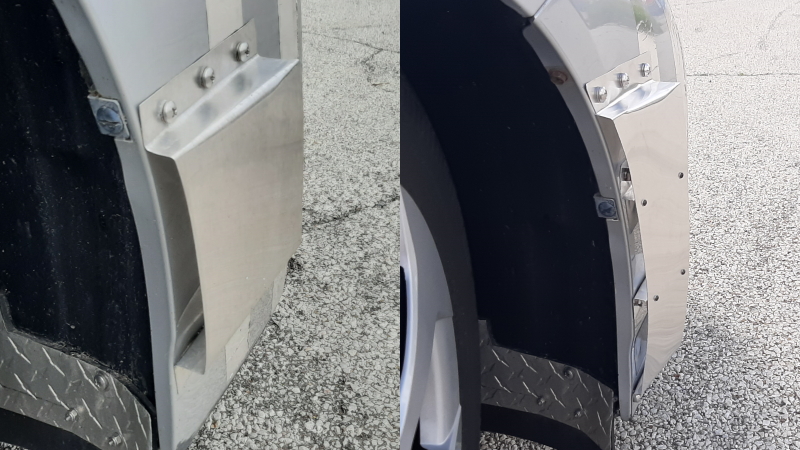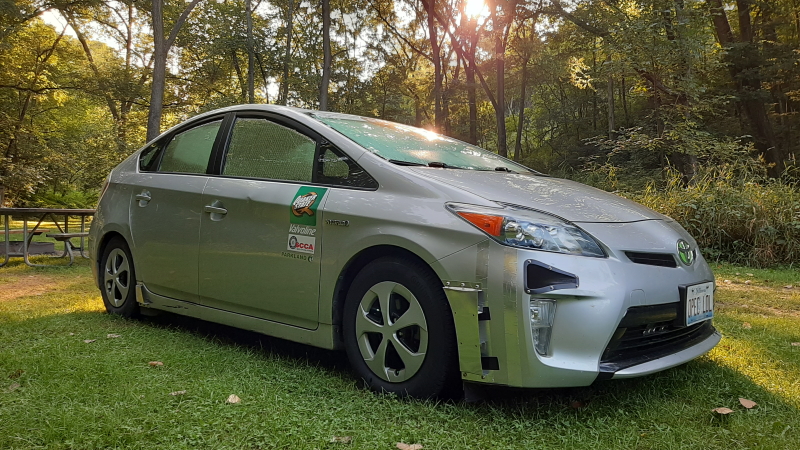I guess it's been a while since I've updated anything here. Addressing previous posts in reverse order:
-Don't remove the air dams in front of the wheels; they exist to reduce wheel drag.
-I never formally tested the cargo box, but did take it to the Green Grand Prix in 2018 (and on to NYC, after which I decided to remove it--parking, maneuvering, and reduction in rear visibility with it on was a bear). It was good for 62.8 mpg at the competition and returned 55.3 mpg on the trip to New York and back.
-I did test the air curtain ducts, both with coast downs and fuel economy over a section of road. The first version of the front ducts increased drag about a third as much as rolling all the windows down, but adding the rear ducts to it reduced drag so that there was no change from no ducts at all. The front ducts also noticeably and negatively impacted stability--the front end felt "squirrelly" in crosswinds, passing truck wakes, etc.
So, I removed the first version and made a second version. These are larger, covering more of the wheel arch, have strakes inside to guide airflow, and are horizontal. I reduced the outlet width to 12mm from 15mm, so exiting air is ~2.5x as fast as inlet.
 Air curtain ducts. First version, left. Second version, right.
Air curtain ducts. First version, left. Second version, right.
Coast down tests with the front ducts on and off (with rear ducts on for both) were inconclusive--there was just too much variability to measure a small effect. So I went out on a calm night on US 45 and measured fuel economy over a 3-mile section north and south, 6 runs in each configuration. Front ducts alone showed 0.29% decrease in fuel economy at 55 mph (70.1 mpg average base/69.9 mpg front ducts), but adding the rear ducts showed 1.28% improvement in fuel economy over no ducts at all (70.1 mpg base/71.0 mpg front and rear ducts); it appears the efficiency improvement is attributable to the rear ducts or some synergistic effect between rear and front. Further, the car is extremely stable with the new front ducts, which is reason enough to keep them on.
 Black tape indicates attachment flanges of original ducts.
Black tape indicates attachment flanges of original ducts.
-Another recent project: I noticed in Toyota's press package for the 2016 Prius a reference to the "fresh air intake" to improve fuel economy and a valve setup to switch to engine bay air if the intake tube gets clogged with snow or debris. I had thought the intake was not routed to the outside of the car after looking at it at an auto show, so I looked more closely at the parts catalog and it does indeed take in air via a tube that goes over the radiator to the high-pressure, ambient-temperature air at the front of the car.
 #10 in this image.
#10 in this image.
Curious, I looked at my pictures of the Honda Insight and Hyundai Ioniq, and they appear to do the same. So I decided to experiment with reducing intake air temperature by taking in fresh air. Using the Scangauge, I measured IAT on the highway with no tube attached to the airbox (12-15 F degrees above ambient), a tube run to the stock intake location behind the passenger headlight (11-12 F degrees above ambient), and then fabricated an intake using a NACA duct (6-8 F degrees above ambient). The NACA duct was necessary for its good pressure recovery, since the structure of the front end of the 3rd generation Prius didn't allow me to run a tube anywhere in the high pressure zone on the face of the car.

I included a secondary intake tube by using a 2" PVC elbow with a 1 1/2" T that's open to the engine bay. This is similar to the intake box setup of the Dodge Challenger SRT Hellcat, which has a headlight intake tube feeding directly to the box and a bottom open to the fenderwell as a secondary intake source. At higher speeds, there's enough pressure at the inlet to feed outside air to the airbox, but if that ever gets clogged with snow or debris and the pressure drops below engine bay pressure, the intake will draw bay air instead. Also, the 1 1/2" pipe points down as the main intake tube goes up about a foot to clear the radiator subframe, allowing for water drainage and using gravity to prevent water and debris reaching the airbox. I tested it this week in a series of Midwest downpours and it functioned as intended--no misfires, no codes, filter and airbox completely dry afterward.
-610 mi camping trip this week, taking a mix of interstates and US highways to the northwest part of the state and back, returned an indicated 61.0 mpg on the display.
 At Mississippi Palisades State Park, Savanna, IL.
At Mississippi Palisades State Park, Savanna, IL.